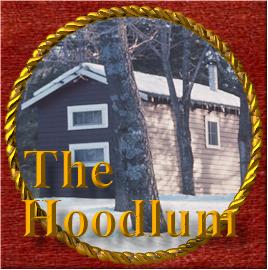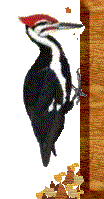The Story of the Hoodlum
By Doug Severt
Edited by Joyce Severt
Born of a desire to have a mobile camp to use during hunting and fishing
expeditions, the Hoodlum had it's beginning like so many things in Norm
Severt’s life; created from depression era ingenuity! He used that ingenuity
to build a mobile home from an old car frame and material that he obtained
from the local area. It was the early 30s, times were rough and you didn’t
throw anything away.
To build the Hoodlum, Norm’s first priority was to get the lumber. Between
him and his brother Roy who was in the logging business, they went to a
farmer near Bethel where there were a lot of windfall trees. With their
dad’s horse, they went there and sawed the logs off to lengths that they
could manage. After the logs were cut into 10 or 12-ft. lengths and all the
rotten spots cut out, they loaded the logs onto a wagon. Usually, they could
only carry three logs at a time. They hauled the timber down to the sawmill
of Herman Miller in Arpin, who cut it up for a very reasonable price. Norm
then reciprocated by delivering slabs to his customers for him. This timber
would later become the frame of the Hoodlum. The siding would come from a
neighbor who was replacing the siding on their house. The tin for the roof
also came from a neighbor whose shed had blown over and was no longer
usable. The interior walls and ceilings would be made from heavy cardboard
that came from discarded shoring and bunker material that he removed from
railway cars at a box factory in the Rapids. With plans to build the Hoodlum
in his mind he brought all of these materials home on his railroad push car
preparing for the day that he would have all the materials together to
assemble. Norman was a very crafty and industrious builder who never missed
an opportunity to utilize anything worthwhile that had been discarded for
any of his numerous projects.
The Hoodlum is about 15 feet long by 6 feet wide. Large double bunk beds
bought at an army surplus store for $1.50 each are on one end and a coal
burning pot bellied stove that was originally in a caboose is to the left of
the entrance. Other amenities included a drop down table, cabinets with
counter tops on the wall opposite of the table and a closet to the right of
the entrance.
The Hoodlum, when first brought to the Turtle Flambeau flowage in Northern
Wisconsin, was parked at the dam site, where Emil (Norm’s brother) then
lived. At that time, that was the main access point to the flowage and there
were no other structures present. The Hoodlum called many lots home for a
while as it only stayed in one place for a limited amount of time. After
Emil began guiding for Art Schmidt, it was moved to his Resort where he
lived while he was guiding. Later, it was moved nearer to the water and next
to the cabin of John A. Blum. At this time the wheels were removed and the
structure was placed on a skid, never to be roadworthy again. The time must
have been around 1936, because that is the year of the last trailer license,
which still remains on it to this day. The last move was to a site next to
the cabin that Norman built. For that move, Joe Lavina a local farmer, used
his tractor and drug it over on its skids. Norman cleared this property and
built his cabin, boat house, tool shed and outhouse. Norman eventually sold
this property to his brother Emil who in-turn sold it to Jimmy Blum, who is
the present day owner.

About 1946 when the Hoodlum was at the Blum's cabin, a late afternoon storm
struck. When the cyclone hit, John A. Blum was in the Hoodlum taking a nap.
On this day, Norman saved John’s life, as he was the only one who knew where
he took his afternoon naps. Norm got him out just in time as trees were
coming down in every direction and the storm was making a loud roar. Trees
were everywhere! Two fell on the Hoodlum, one fell on the corner of John’s
cabin. It took them two days to clear the trees off the road with crosscut
saws so they could get out. When the roof was repaired, the pitch of the
roof was increased. It originally had a flat roof.
From my earliest recollections, the Hoodlum was primarily a place for the
kids. I can remember only a few times when adults slept in it, but for the
most part it was our private domain. A perfect gathering place out of sight
and hearing of adults. We could stay up all night listening to Dick Bianti
on radio station WLS out of Chicago and no one bothered us. Nighttime was
the only time that we could receive the station and then the receptions was
seldom very good, but it was our only source of the latest music.
The Hoodlum was the best place to sleep in, except for making the bed. That
was cumbersome because it was wall-to-wall bed and you only had access from
one side. In order to tuck in the opposite side you had to crawl on the bed
and try to tuck it in, but by the time you got back off, it probably came
out from all the movement on the bed because we didn't have fitted sheets.
That was the only draw back, however. The Hoodlum was built is such a way
that the end wall had two windows, one on top of the other. This afforded
each of the bunked beds a window of their own and with them open, it was as
if we were sleeping outside but we had the comfort and security of the
Hoodlum. Any time was a perfect time to nap. When it rained one could hear
the rain falling on the leaves and on the tin roof. When it was windy the
wind rustling the leaves could always lull you to sleep. During the day you
could always hear the distant drone of an outboard motor and could trace the
movement of it on the lake in your mind from the sound and sometimes even
identify who it was. On cold mornings, even the smallest fire would heat the
building nicely.
How did it get its name? No one knows for sure. And really, no one cares.
All we know is the sheer, unbounded joy that we experienced at this place
that hailed from such meager beginnings.




